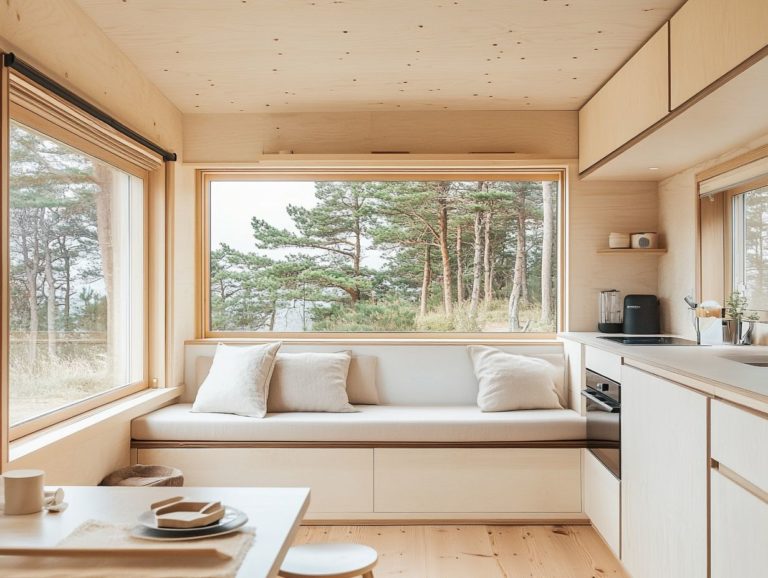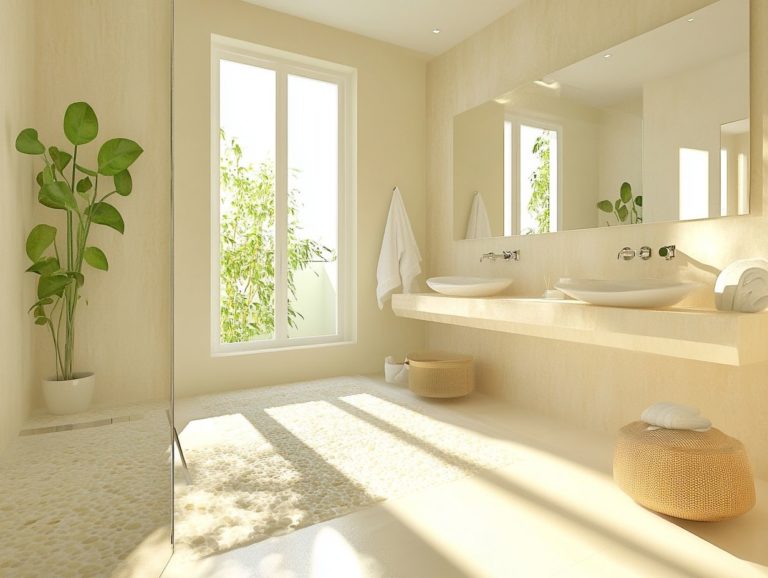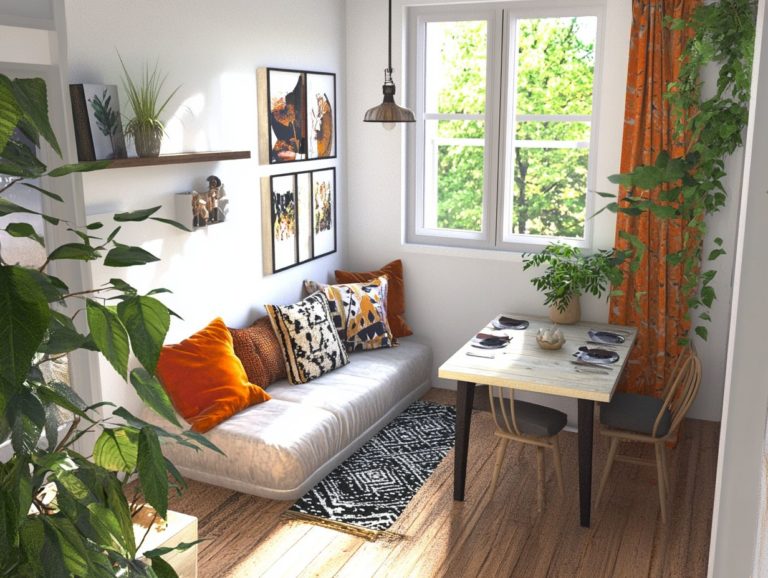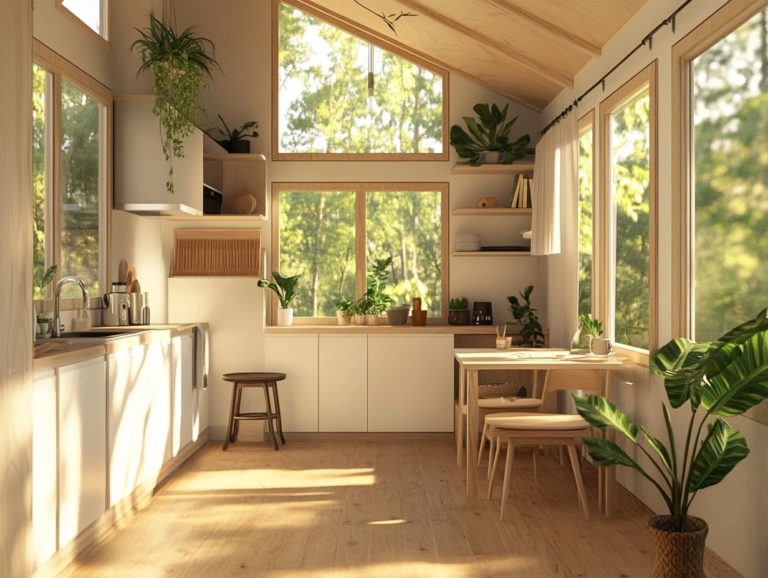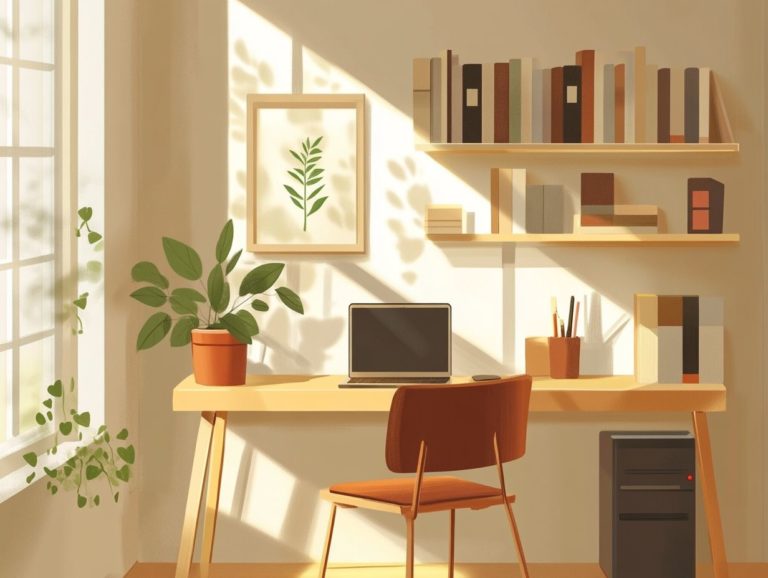Reimagining Spaces in Tiny House Living
The tiny house movement transcends mere trendiness; it’s a lifestyle revolution that champions simplicity, sustainability, and imaginative design.
As you seek to reduce your environmental footprint and embrace a clutter-free way of living, tiny houses present a compelling solution.
This article delves into the myriad benefits of tiny living, highlighting innovative storage strategies, the art of creating multi-functional spaces, and the importance of maximizing natural light.
Uncover how to transform small areas into stylish, functional homes that not only reflect your personal values but also nurture a profound connection with nature.
Contents [hide]
- Essential Takeaways for Tiny House Living:
- The Rise of Tiny House Living
- Designing for Small Spaces
- Innovative Storage Solutions
- Creating Multi-Functional Areas
- Maximizing Natural Light
- Outdoor Living in Tiny Houses
- Utilizing Outdoor Spaces for Living and Storage
- Designing for Sustainability
- Frequently Asked Questions
- What is the concept of reimagining spaces in tiny house living?
- What are some common challenges when it comes to reimagining spaces in tiny house living?
- How can I make the most out of my tiny house living space?
- Are there any design strategies or principles that can help with reimagining spaces in tiny house living?
- Can I still have a comfortable and functional kitchen and bathroom in a tiny house?
- Is reimagining spaces in tiny house living only for those with minimalistic lifestyles?
Essential Takeaways for Tiny House Living:

- Tiny house living offers numerous benefits, such as affordability and simplicity, and is a growing trend in the housing industry.
- Designing for small spaces requires balancing functionality and aesthetics, with creative solutions for maximizing space and creating a visually appealing environment.
- Innovative storage solutions, multi-purpose areas, and utilizing natural light and outdoor spaces are key strategies for making the most out of tiny house living.
The Rise of Tiny House Living
The rise of tiny house living signifies a profound transformation in how you view your living spaces, placing emphasis on sustainability, financial freedom, and community engagement.
As interest in minimalist lifestyles swells globally, you may find yourself drawn to the tiny house movement as a practical pathway to living in an environmentally friendly way and lowered expenses.
This trend champions compact living and underscores the value of DIY projects and innovative design. It inspires you to explore creative space-saving solutions that redefine the essence of modern living.
Exploring the Trend and Its Benefits
Exploring the trend of tiny house living reveals a wealth of benefits that align perfectly with your pursuit of a minimalist and eco-friendly lifestyle.
This choice is not just about smaller spaces; it’s a game changer! It offers significant financial advantages, including significantly reducing your monthly bills and lower maintenance expenses.
You can also benefit from tax advantages associated with smaller properties. This allows you to redirect your finances toward saving or investing in enriching experiences rather than accumulating material possessions.
With specialized loans designed specifically for tiny houses, you can easily navigate the typical hurdles of traditional mortgages.
By embracing minimalism, you not only simplify your life but also consciously reduce your carbon footprint. Utilizing sustainable building materials and energy-efficient designs gives you the power to coexist harmoniously with your environment while enjoying the freedom that comes from living simply.
Designing for Small Spaces
Designing for small spaces demands a keen eye for innovative principles that effortlessly incorporate furniture that serves more than one purpose and built-in storage solutions.
By maximizing every inch of available space, you can significantly enhance the overall livability of tiny houses, creating a harmonious blend of style and functionality.
Maximizing Functionality and Aesthetics
Maximizing functionality and aesthetics in tiny home design means you ll want to harness creative space-saving techniques while integrating smart home technology and natural materials.
By rethinking conventional layouts, you can seamlessly incorporate multi-purpose furniture, like foldable tables and built-in storage solutions, enhancing both usability and visual appeal.
Embracing smart home technology allows you to remotely control lighting, heating, and security features, making even the coziest spaces feel more expansive and tailored to your needs.
Utilizing natural materials such as reclaimed wood and bamboo not only creates a warm, inviting atmosphere but also aligns with eco-friendly principles, promoting a sustainable lifestyle without compromising on style. This harmonious blend of creativity and practicality will transform your tiny home into a stylish sanctuary.
Start your tiny house journey today and discover the freedom that comes with living simply!
Innovative Storage Solutions
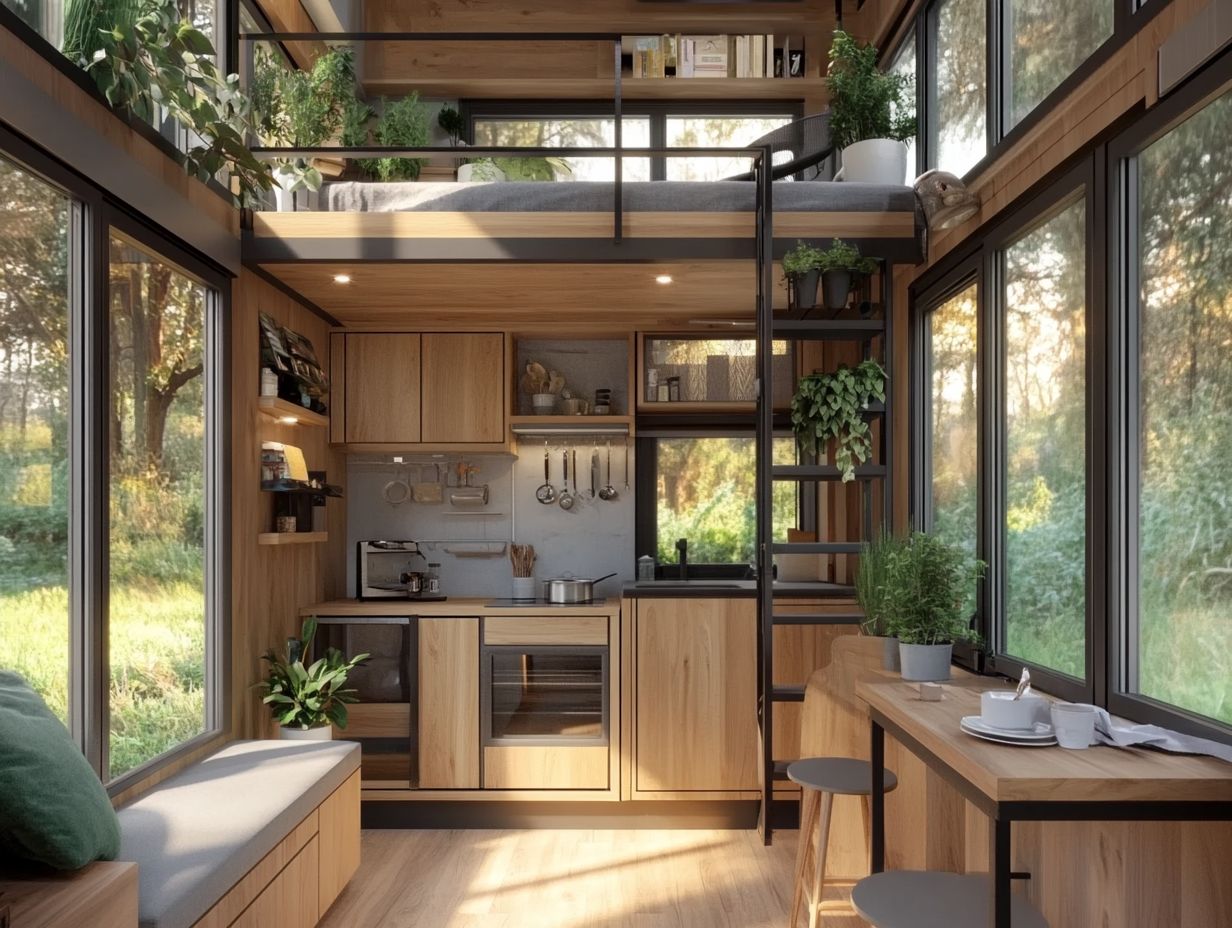
Innovative storage solutions are paramount for tiny homes. They enable you to maximize vertical space and craft efficient built-in storage options.
Consider incorporating shelving units and foldable furniture to enhance functionality while maintaining a sleek aesthetic.
Clever Ways to Save Space and Stay Organized
Cleverly saving space and staying organized in tiny homes often hinges on using multifunctional furniture. Eco-friendly upgrades can elevate functionality while maintaining an organized space.
By choosing items like sofas that transform into beds or tables that effortlessly fold away when not in use, you can make the most of your limited square footage.
Eco-friendly upgrades, such as reclaimed wood shelving or composting systems, not only champion sustainability but also offer stylish storage solutions that blend seamlessly with your decor.
Getting creative with outdoor spaces perhaps by introducing vertical gardens or compact patios can effectively extend your living area without the burden of expensive expansions.
These strategies create an open and inviting environment, even within the constraints of a smaller space.
Creating Multi-Functional Areas
Transform your tiny home with multi-functional areas! They make every inch count, turning these compact spaces into versatile environments that cater to a range of needs.
Transforming Spaces for Different Uses
Transforming spaces in tiny homes for various uses is entirely achievable with flexible layouts and innovative features. For instance, retractable roofs can flood the living area with natural light.
These design elements not only elevate the visual charm of compact living environments but also foster a sense of openness.
By incorporating modular furniture, you can effortlessly transition between relaxation, dining, and workspace configurations.
Large windows and thoughtfully positioned mirrors can amplify sunlight, creating a light and airy atmosphere.
The combination of movable walls and adjustable shelving allows for seamless reconfiguration, ensuring that every corner serves multiple purposes.
Such versatile designs empower you to embrace a lifestyle that feels spacious, inviting, and incredibly functional, no matter the limited square footage.
Maximizing Natural Light
Don’t miss out on maximizing natural light it could transform your tiny home! It not only amplifies the sense of space but also champions eco-conscious living.
By embracing innovative solutions, such as smart home technology, you can significantly reduce your reliance on artificial lighting, creating a harmonious and sustainable environment.
Strategies for Bringing in More Light
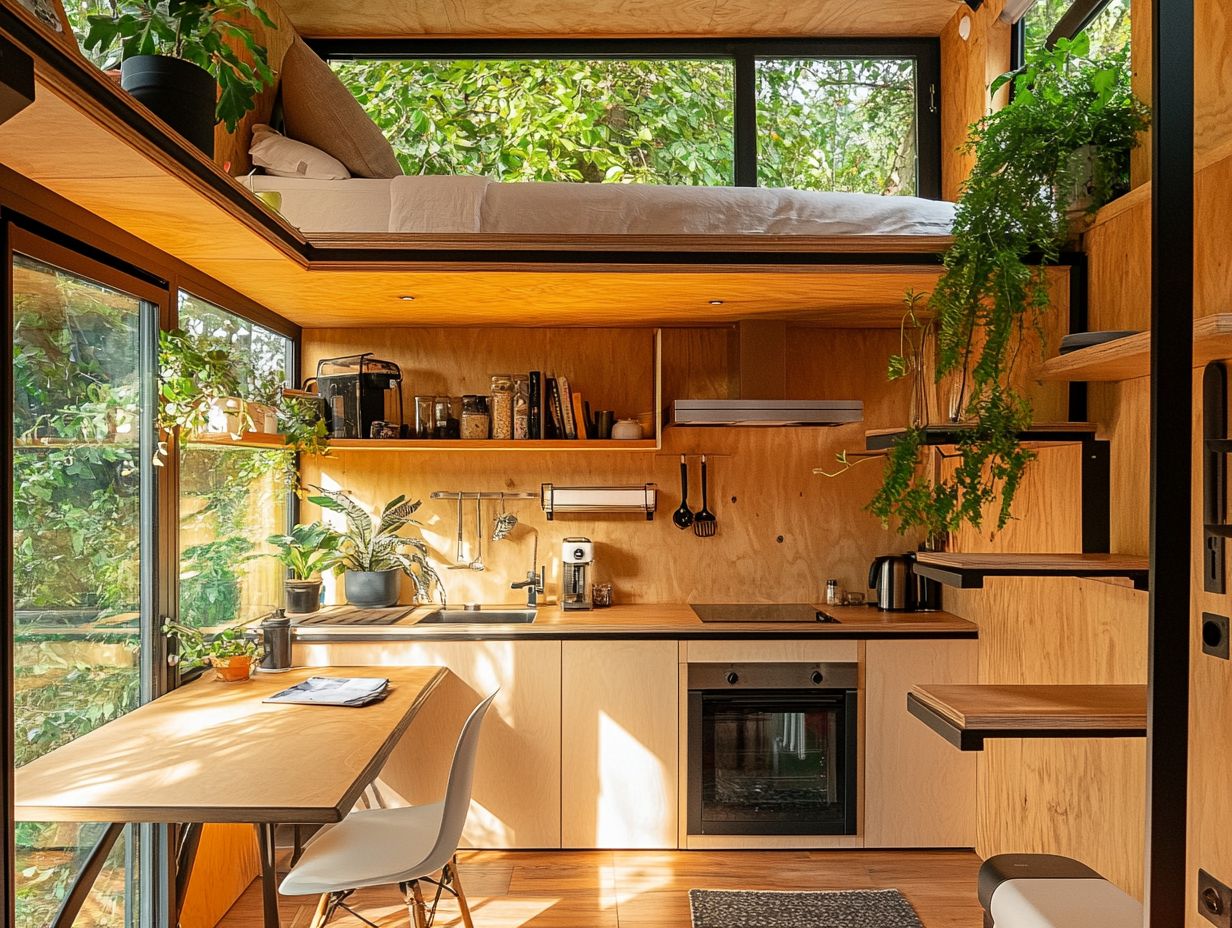
Implementing strategies to illuminate your tiny home can involve incorporating large windows, skylights, and reflective surfaces. These features cultivate a bright and airy atmosphere.
These design elements not only create a sense of openness but also optimize the limited space typical of tiny living.
By placing large windows on the southern or western walls, you can capture sunlight during peak hours. This allows warmth and brightness to fill your interiors throughout the day.
Adding skylights further enhances this effect, providing direct access to overhead light, which is especially advantageous in spaces with limited wall areas.
Incorporating reflective surfaces, like mirrors or glossy finishes, amplifies this illumination by bouncing light around the room, making even the coziest corners feel spacious and inviting.
Outdoor Living in Tiny Houses
Embracing outdoor living in tiny houses is essential for optimizing your space. It enables you to make the most of your outdoor areas, seamlessly integrating them into your cozy micro-living environment.
This approach not only enhances your lifestyle but also expands your living area. You can enjoy nature while maintaining the comforts of home.
Utilizing Outdoor Spaces for Living and Storage
Utilizing outdoor spaces for living and storage is easily achieved by incorporating patios, decks, and vertical gardens that extend your living area beyond the confines of your home.
Transform these areas into functional extensions of your lifestyle to make the most of your tiny home. Picture your patio adorned with comfortable seating and a fire pit, creating the perfect setting for evening gatherings or quiet moments of reflection under the stars.
Your deck also serves as an excellent platform for entertaining guests or savoring morning coffee while soaking in the beauty of nature.
Add vertical gardens to create a vibrant and relaxing space. These creative solutions not only conserve ground space but also enhance the aesthetic appeal of your outdoor areas. They facilitate a seamless blend of living and storage capabilities that elevate your experience while promoting eco-conscious and compact living.
Designing for Sustainability
Designing for sustainability in tiny homes involves integrating eco-friendly upgrades and utilizing natural materials. It s essential to navigate zoning laws meticulously to ensure compliance while championing sustainable living choices that resonate with your values, such as minimalist lifestyle choices.
Eco-Friendly Features and Practices for Tiny Houses
Incorporating eco-friendly features and practices into your tiny house can transform your space into a model of sustainability. Installing solar panels, rainwater collection systems, and composting toilets enhances your home’s ecological credentials and contributes to the tiny house movement.
These integrations reduce your ecological footprint and lead to savings on utility bills and water consumption. Solar panels allow you to harness renewable energy for your everyday appliances. Rainwater collection systems capture moisture for irrigation and other uses, all part of an innovative design approach.
Composting toilets are water-saving fixtures that turn waste into nutrient-rich compost, minimizing water usage and promoting organic gardening. By embracing these practical solutions, you create a more self-sufficient lifestyle and encourage a harmonious relationship with nature while enhancing your tiny home community.
Frequently Asked Questions
Here are some common questions about tiny house living:
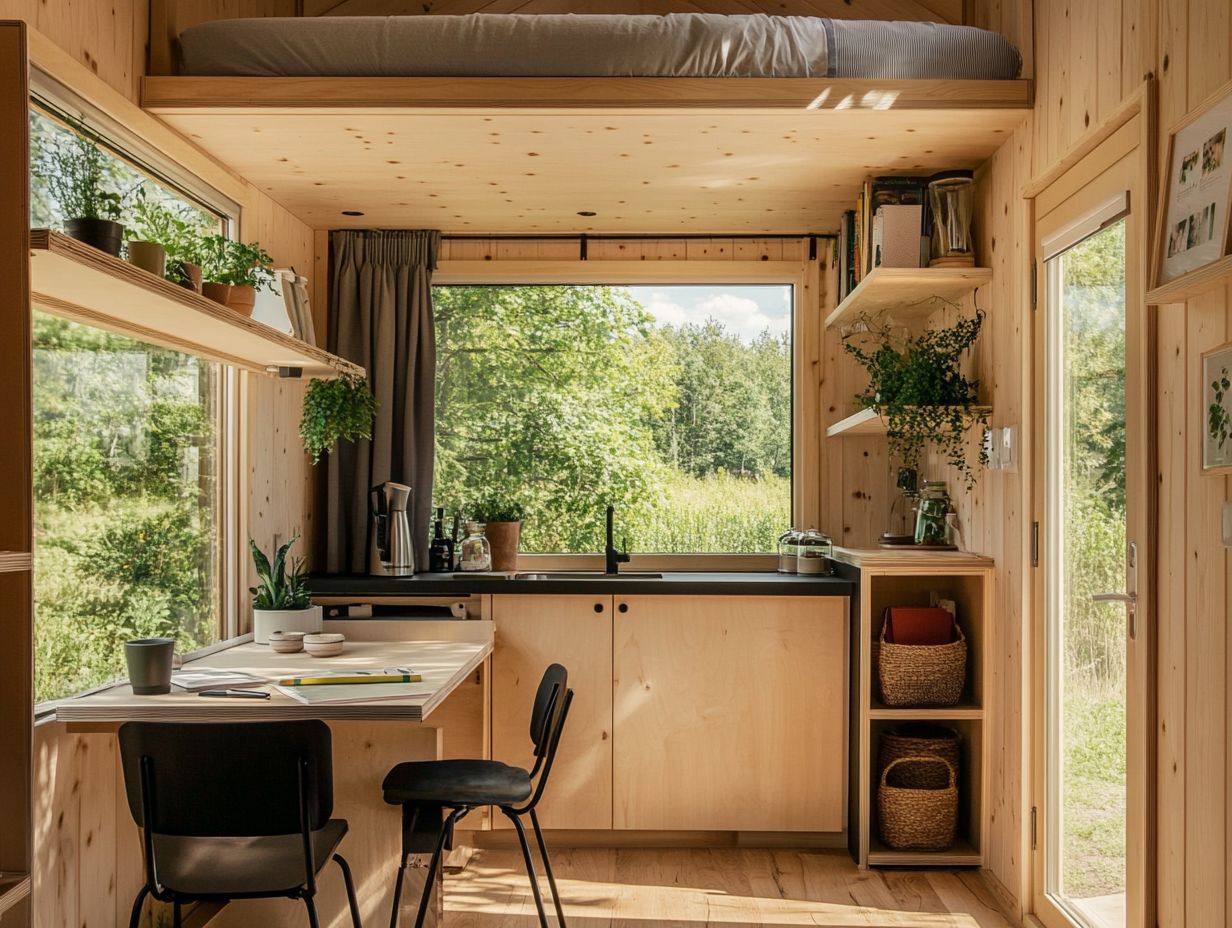
What is the concept of reimagining spaces in tiny house living?
Reimagining spaces in tiny house living means thinking creatively and efficiently about how to use the limited space in a tiny home to maximize its functionality and livability.
What are some common challenges when it comes to reimagining spaces in tiny house living?
Common challenges include incorporating storage, using multipurpose furniture, and maximizing vertical space in a small area.
How can I make the most out of my tiny house living space?
Tips for maximizing space in a tiny home include using multifunctional furniture, utilizing vertical space with built-in storage solutions and shelving, and embracing a minimalist lifestyle.
Are there any design strategies or principles that can help with reimagining spaces in tiny house living?
Yes, design strategies include using light colors to create an illusion of more space, incorporating natural light, and using reflective surfaces to make the space feel larger while considering creative space-saving solutions.
Can I still have a comfortable and functional kitchen and bathroom in a tiny house?
Yes, with careful planning and creative space-saving techniques, it is possible to have a fully functional and comfortable kitchen and bathroom in a tiny house by utilizing foldable furniture and built-in storage options.
We encourage you to share your own tips or experiences with tiny house living!
Is reimagining spaces in tiny house living only for those with minimalistic lifestyles?
No, reimagining spaces in tiny house living can work for anyone. It’s about using clever solutions to make the most of your space.
Smart home technology and DIY projects can help you customize your environment to fit your lifestyle perfectly. Discover how these tools can transform your living experience!

